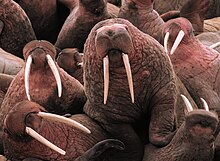The Walrus: Possibly the fattest, ugliest sea creature I written up. These blubbery, long tusked freaks are the last in the Odobenidae species that are left. Both girl and boy walruses have tusks. The tusks are actually very long canine teeth. They can grow to be over 3 feet long and weigh up to 12 pounds. Wouldn't you HATE to have THAT on your face???
Walruses live in the Arctic Sea, and their hibernation is when it is warm: summer through fall. This technically means that they stay awake through winter. Now, you are probably wondering how they do it. I mean, look at them! But a walrus stays warm by 2 layers of skin, one of skin and one of blubber. Both of these layers put together gives a walrus skin 9.8 inches thick.
Walruses are BIG. They can grow to be 4400 pounds in total by the time hey are adult. This weight would make an average walrus overweight though. Their normal weight is typically 3700 pounds.


